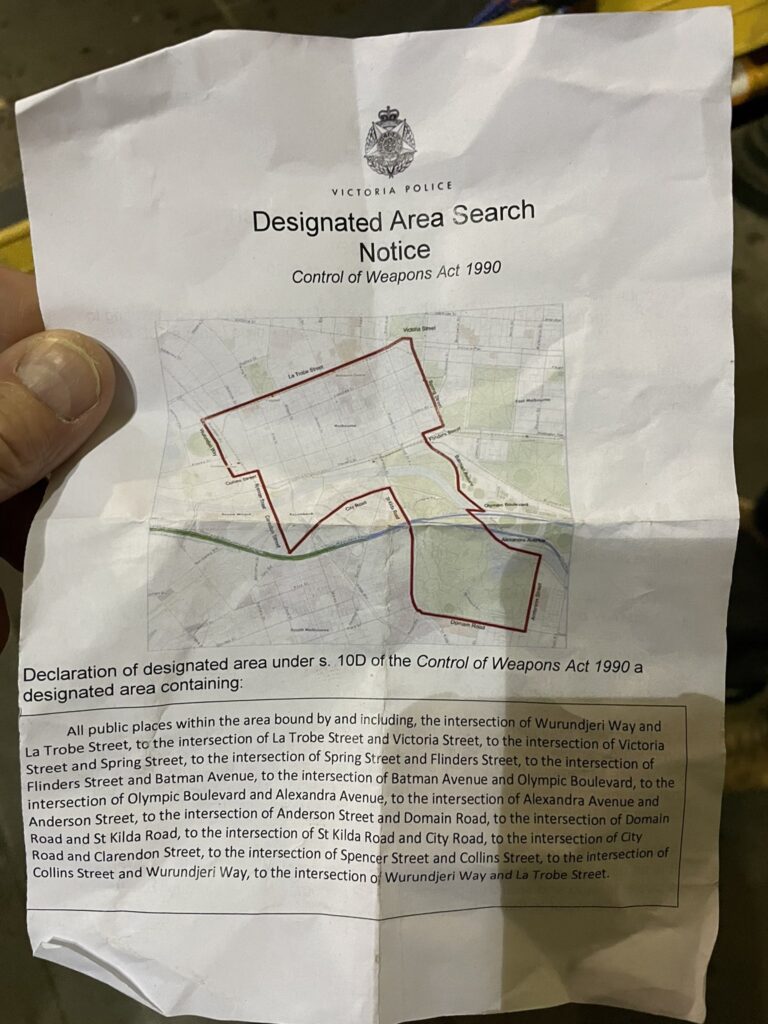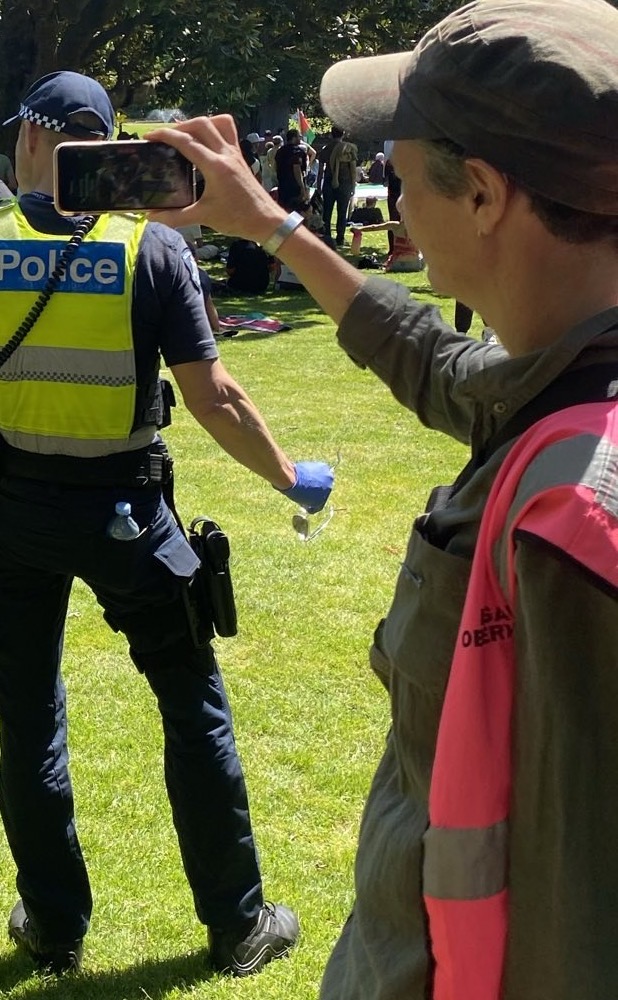Your rights in Designated Areas

This is a legal rights guide on the three main police powers affecting people at protests inside a ‘designated area’:
- searches
- directions to remove face coverings
- directions to leave the area.

What is a ‘Designated Area’?
Victoria Police has powers to ‘designate’ areas under the Control of Weapons Act 1990 (Vic).
Sometimes, Victoria Police will declare a designated area in the lead-up to a protest event.
Declarations with a map and times should be published here: https://www.police.vic.gov.au/public-notices – or it may be published in a Victoria Government Gazette.
In a designated area, police and Protective Services Officers (PSOs) have additional stop and search powers, powers to order people to remove face-coverings, and to direct people to leave the area.
These additional powers only exist in the designated area and are limited to a maximum of 12 hours.
These powers are not always used by police. But they can be. So knowing your rights in these areas is important.
Searches
In a designated area, police can stop and search any person and anything in that person’s possession like a bag. They can also stop and search any vehicle with people in it.
Police don’t always stop and search protesters, but they can.
In a designated area police don’t need to have proof, nor reasonable grounds or a warrant to search you or your vehicle.
If police search you:
- police can detain you as long as is reasonably necessary to do the search.
- the search must be the least invasive search practicable in the circumstances.
- police should tell you that you’re in a designated area and that they will search you for weapons.
- they can ask you to remove face coverings and outer clothing like hats, scarves or jackets.
- they can ask you to remove things from bags or pockets.
- police can do a ‘pat down’ search (A ‘pat-down search’ is when police pat their hands over the outside of your clothes).
- police may use a hand-held metal-detector wand which is waved over your body without touching you.
- police can search you in public at the spot where they stop you.
- the police officer that does the search should be the same gender as you (unless this is not reasonably possible).
- police should give you a written receipt for anything they take away from you, including drugs or prescriptions.
The police can charge and fine you if you refuse a search, or obstruct or hinder a search of a person or vehicle.[1]

Police only have the power to demand a name and address if they believe an offence has been, or is about to be committed, if you are driving a vehicle, or if the search happens to be on public transport property. It is an offence to refuse to give police your name and address, or to give police a fake name and address, if they have a lawful reason to ask you for your details.
If you are searched:
- Stay calm. Searches can be fast and confusing.
- Advise the police that you will not resist, but that you do not consent to the search.
- Ask the police to tell you their name, rank, and station in writing.
- They may give you a search notice or a card. If you receive a search notice, card or receipt, keep it safe for your own record.
- You do not have to give your name and address during a search unless:
- police believe you have committed an offense
- you are being searched on public transport property.
- Ask a friend or bystander, or a MALS legal observer to monitor the search.
- Make a short note of when, where and what happened soon afterwards.
- If you feel like you were unfairly targeted or profiled, mishandled or assaulted in any way during the search, or have had items seized by police, you can seek legal advice about making a complaint or taking legal action: Supportive law firms
If you are searched at a protest please send a short email report to [email protected] for our monitoring.
Directions to remove face coverings
Police can direct a person who is wearing a face covering (a mask) to remove it and/or to leave the designated area.
Police must reasonably believe that the person is wearing the face covering primarily to conceal their identity or to protect themselves from the effects of crowd-controlling substances.
You can still wear a mask or a face covering at a protest when you are in a designated area. It is only an offence if you refuse to remove it if you are directed to by a police officer.
Face coverings can be worn for religious reasons and, since the COVID-19 pandemic, masks have been widely worn for public health purposes. It may be hard for police officers to legitimately direct people to remove face masks.
It is an offence to refuse a direction given by a police officer to remove a face covering or to leave the designated area.
If police direct you to remove a face covering:
- Remain calm.
- You can ask why you are being asked to remove your face covering.
- You may be given a choice to remove the face covering or to leave the designated area if you don’t want to remove the face covering. You can ask where the boundary is and how long the direction applies.
- Take note of what the officer said to you. As soon as you can, make a short note of when, where and what happened.
- If you believe the direction to remove your face covering was unfair, discriminatory or infringed upon your right to participate in the protest you can seek legal advice about making a complaint or taking legal action: Supportive law firms.
If you are asked to remove a face covering at a protest please send a short report to [email protected]
Directions to leave the area
A police officer can direct a person to leave a designated area if the person has refused a direction to remove a face covering, or that officer reasonably believes that the person intends to engage in an ‘affray or violent disorder.’[2]
If police direct you to leave the designated area:
- Remain calm.
- Ask why you are being directed to leave.
- Ask where the boundary is and how long the direction applies for.
- Take careful note of what the officer says to you. As soon as you are able, make a short note of when, where and what happened.
- You may be asked for your name and address. In this circumstance, you must provide your name and address.
- If you are able to, video or record the police request to leave.
- If you believe the request to leave the area is unfair, discriminatory or has infringed upon your right to participate in the protest you can seek legal advice about making a complaint or taking legal action. Supportive law firms.
If you have been directed to leave a designated area during a protest please send a short report to [email protected]
Notice: Legal Info for Victoria, Australia only. Up to date as at November 2023. This is not legal advice.
Further reading and our concerns
Using these powers to control or limit participation in protests is deeply problematic. These powers have not yet been challenged in court. For a detailed MALS critique of these powers see Designated areas as protest control.
[1] It is an offence to fail to comply with a direction given by a police officer without a reasonable excuse. A penalty of five penalty units applies to this offence (s 10L(2) CW Act).
[2] A police officer may exercise their power under s 10KA CW Act to request you to remove any article covering your face or direct you to leave the designated area if you refuse to remove the face covering, or if the police officer reasonably believes that you intend to engage in conduct that would constitute an affray under s.195H, Crimes Act 1958 or violent disorder under s.195I, Crimes Act 1958.